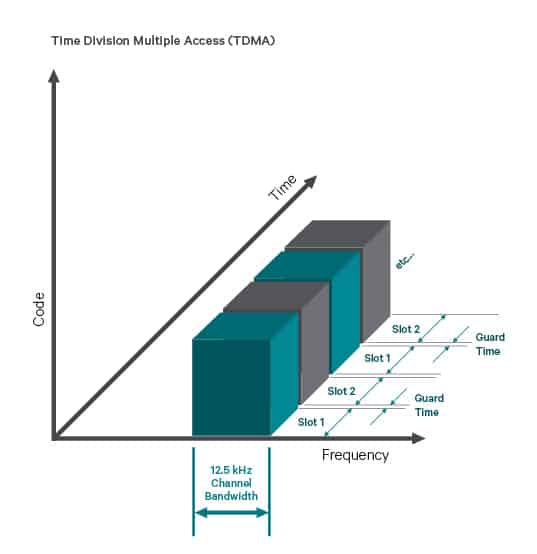Phase 1 or Phase 2
A similar argument can be made when deciding whether to implement P25 Phase 1 or Phase 2. The main difference between the two phases is system capacity, so the primary reason for opting for Phase 2 is additional capacity.
Phase 2 TDMA (Time Division Multiple Access) doubles the number of talk paths compared with Phase 1. P25 Phase 2 TDMA creates two logical channels in one 12.5kHz physical channel. Because the Phase 2 control channel is unchanged from Phase 1 there is compatibility between the phases.
| P25 Phase 1 vs. Phase 2: functionality comparison | |
|---|---|
| Phase 1 can be used in trunked or conventional configurations. | Phase 2 is currently available in trunking only. |
| P25 Phase 1 technology is about +7dB better than 25 KHz Analog and close to +10dB better than the newly required 12.5 kHz analog for the same Delivered Audio Quality (DAQ) | There is no significant differences between Phase 1 and Phase 2 for basic RF coverage. However, for simulcast systems, Phase 2 sites may need to be spaced closer to avoid time delay interference (TDI) since the acceptable delay spread for Phase 2 is smaller than that for Phase 1 |
| Phase 1 equipment has been undergoing compliance testing sanctioned by the Federal Government Compliance Assessment Program ( CAP), sanctioned by the Department of Homeland Security. | Phase 2 equipment has been CAP tested since 2017 |
| Phase 1 cannot support interactive power control or interrupt on-going transmission from SUs. | Phase 2 is capable of interactive power output control and can interrupt on-going transmission from subscriber units. |
Phase 2 is appropriate for large urban areas with high user density and a requirement for more efficient use of radio spectrum. You should specify Phase 1 that is upgradeable to Phase 2, and specify that the implementation and costs of such an upgrade are clearly identified in proposals.
| True or False: Common myths and misconceptions about P25 Phase 2 | ||
|---|---|---|
| Phase 2 is necessary for FCC Narrowbanding | False | Phase 1 equipment meets FCC narrowbanding requirements |
| Phase 2 brings added functionality to Phase 1: | False | marginal functions only |
| Everyone should upgrade to or install Phase 2 | Absolutely false! | |
| Phase 1 is an obsolete standard and being replaced by Phase 2 | False | Phase 2 augments Phase 1, to address the infrequent situations where increased traffic capacity is needed, but does not replace Phase 1. |
| Phase 2 has to use 700/800 MHz spectrum. | False | Phase 2 can be offered in any frequency band |
Click "NEXT" to learn about System Architecture or select a topic from the menu below.




[…] is concerned, or are we good to go with Phase 1 for many years yet?? EDIT: Based on this info: P25 Phase 1 or Phase 2 | P25 Best Practice Note the section: "Common myths and misconceptions about P25 Phase 2" I would bet KS […]
Hi there.
Thank you for your comment.
The audio of the Tait P25 Phase 1 radios are excellent. Perhaps you’d like to request for a demo at the nearest Tait dealer in your area?
For the Phase 2 radios, the improvement is more on spectral efficiency rather than audio.
Kind regards